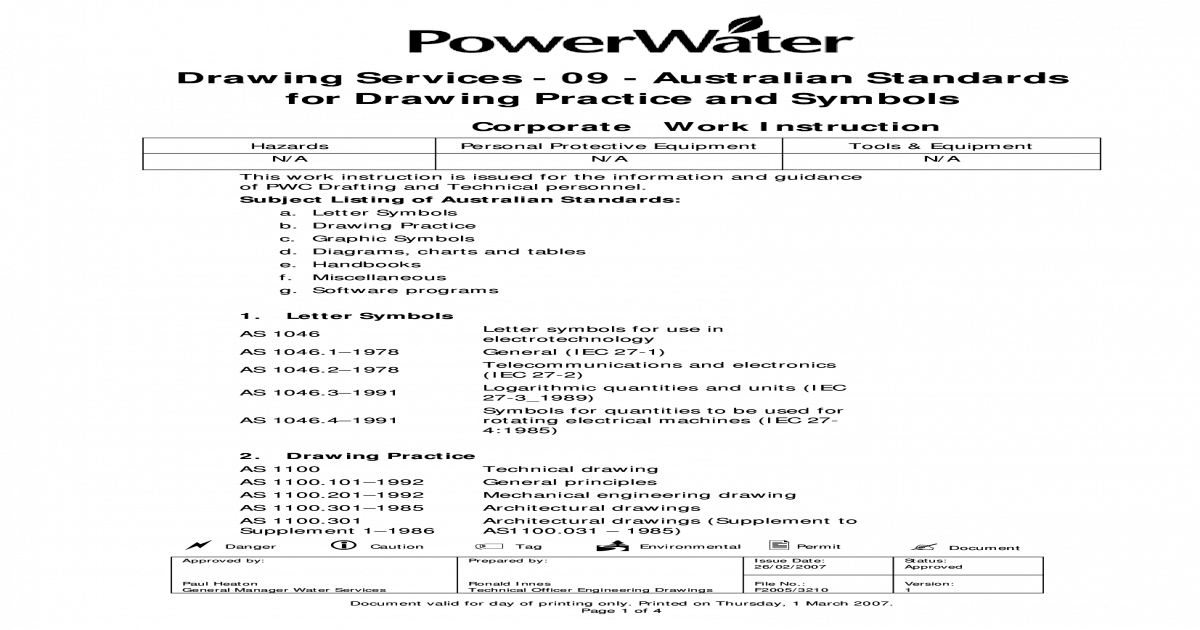
Glossary
Australian Standard® Technical drawing Part 301: Architectural drawing AS 1100.301—2008 This is a free 6 page sample. Access the full version online. This Australian Standard® was prepared by Committee ME-072, Technical Drawing. AS 1100.401 Technical drawing – Engineering survey and engineering survey design drawing AS 1100.501 Technical drawing - Structural engineering drawing AS/NZS 1101.1 Graphic symbols for general engineering - Hydraulic and pneumatic systems. AS 1100.301—2008 2 PREFACE This Standard was prepared by the Joint Standards Australia/Standards New Zealand Committee ME-072, Technical Drawing, to supersede AS 1100.301—1985, You've reached the end of your free preview.
Australian Standard AS 1100.101-1992 tells us how to specify and interpret engineering drawings. Most engineering drawings are produced in accordance with this Standard.
A Standard sets out specifications and procedures to make sure a material, product, method or service can do what it is meant to do and perform consistently the way it is meant to perform.
Look around and see if you can find examples of standardisation in your workshop. For example, conformity in screw and thread sizes means that a nut made in Adelaide will fit a bolt made in Germany.
Standards give us a common language. Whether you speak English or Greek, you can still interpret an engineering drawing by referring to the standard for technical drawing.
The drawing on the left is done to the Australian Standard AS1100.101-1992 so it can be interpreted consistently in any country.
Australian Standard AS 1100.101-1992 sets out the basic principles of technical drawing practice. The Australian Standard specifies:
- the use of abbreviations
- materials, sizes, and layout of drawing sheets
- the types and minimum thicknesses of lines to be used
- the requirements for distinct uniform letters, numerals and symbols
- recommended scales and their application
- methods of projection and of indicating the various views of an object
- methods of sectioning
- recommendations for dimensioning including size and geometrical tolerancing
- conventions used for the representation of components and repetitive features of components.

Lines:
There are a number of different lines that you will be required to use in Technical Drawing. The table below shows you the different lines, describes where they are used and give you an example of each line.
Aia Drawing Standards
| Type of Line: | Use of line in Technical Drawing: | Example of lines: |
| Type A - Continuous, Thick | Visible outlines of the drawing. | |
| Type B - Continuous, Thin | Dimension and projection lines, leaders. Hatching on sections. | |
| Type C - Continuous, Thin (freehand) | Break in the object . | |
| Type D - Continuous, Thin (ruled with zig-zag) | Break in the object (Straight) | |
| Type E - Dashed, Thick | Hidden edges. | |
| Type G - Chain, Thin | Center Lines of circles, arcs and center of objects. | |
| Type H - Chain, Thick at each end and thin in the middle. | Cutting plane in sectioning of objects. |
Where two or more lines of different type coincide, the following order of priority should be observed:
(a) Visible outlines and edges. (b) Hidden outlines and edges. (c) Cutting planes. (d) Centre-lines. (e) Projection lines. |

Selection of views shall be selected according to the following principles:
(a) To reduce the number of views required to fully delineate the information to be specified.
(b) To avoid the need for hidden outlines.
(c) To avoid unnecessary repetition of detail.
Sectioned views:
Sectioning is used to show internal detail or to reduce the use of hidden detail lines that may make the object difficult to recognise. All hidden outlines in the section should be omitted except in special cases.
These types of drawings are Orthogonal's with imaginary lines cutting the object into parts.

Each sectional view or section shall be identified with its appropriate cutting plane, where identified, by inscribing a subtitle below the view or section; e.g. ‘SECTION A-A’, ‘SECTION B-B’.
Cutting planes are to shown using a 'Type H' line with the direction of viewing show by an arrowhead and a letter placed at the tail of the arrow. The cutting plane should pass through the main part of the object.
Hatching:
The cut part of the object is to be shown using with a hatched line (usually at 45°, unless this would make the object more difficult to understand). Where two or more adjacent parts have been sectioned the hatch line should be at different angles.
Angle of Hatching | Sectioning of Adjacent components |
Breaks:
Break maybe used to shorten lone objects and will use Type C or Type D lines.
Symbols:
The following symbols are to be used in dimensioning:
| Symbol: | Use: |
| Diameter symbol, this is used to indicate the diameter of a circle. | |
| R | Radius Symbol, this is used to indicate the radius of a circle or arc. |
| This symbol is used to refer to the object being identified is square and the same size across all surfaces. |
A-s1100 Drawing Standards Free Download
Dimensioning, Projection and Leader Lines:
Objects that are drawn in Graphics often need to have dimensions showing the size and angles used to show detail about the component. Dimensions show the length and angle of items and the drawing should include only the measurements require to describe the object.
Projection lines are lines that extend from the object and extend outside the outline of the drawing where possible. These lines should start and extend past the dimension line.